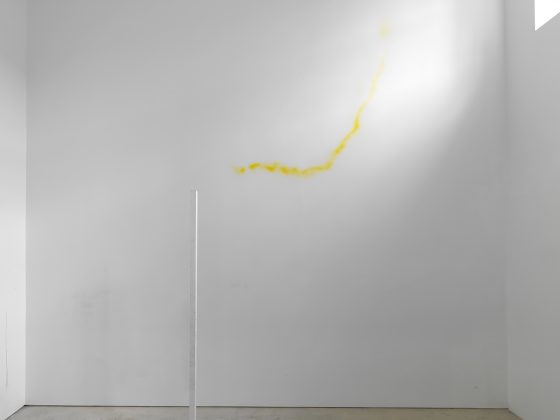
Julius Heinemann: Camera Lucida, installation view, Roman Road, London, 22 Sep – 20 Oct 2014. Courtesy of Roman Road and the artist.
“When does art occur? Is art really created, or does it already exist and is in fact a process of discovery or rediscovery? Can an artist, when developing an exhibition, also double as a visitor? In other words can an artist, like a spectator, share the same initial experience when engaging with space, if the space itself is an integral part of the work?”
– Victor Wang, ‘The Gallery as Site and Subject’, Roman Road, 2014
The myth of the gallery as a neutral space was debunked a long time ago. The “white cube” model, far from being a disinterested blank holder of art, is in fact an historical construct with specific aims and consequences. An understanding of the gallery as context (rather than lack thereof) has been crucial to developing exhibition practices and to the development of exhibition studies as an integral part of the study of art history.
Recently, a number of galleries have been moving beyond the white cube model and offering a vision of the gallery as a specific, rather than generic, container for art with important spatial, temporal, geographical and social qualities. The white cube model, on the other hand, seeks to eliminate the specificity of the art-viewing experience by shutting out both recognition of the outside world, and the personalised role of the viewer.
In his seminal 1976 work Inside the White Cube: The Ideology of the Gallery Space, Brian O’Doherty argues that the white cube space effaces the gallery-goer as an individual. In this context, he claims, “presence before a work of art means that we absent ourselves in favour of the Eye and the Spectator.” We start to consider ourselves in generic terms, an everyman-spectator and an objective, rather than subjective, “eye”.
The viewer is expected to sacrifice their humanness, privileging the work of art. As in a religious space, we whisper rather than talk out loud, stifle our laughter and refrain from discussing anything which isn’t related to the art in front of us. An absence of windows and an indeterminate constant light source can make the space feel detached from reality and from the passing of time. The form of communion with the work of art that is encouraged is emphatically spiritual or intellectual, rather than physical. We feel a desire to touch the art – who doesn’t want to run their hands over a smoothly carved sculpture, or feel the roughness of impasto painting? – but we suppress the urge as if it’s the ultimate taboo.
But some galleries are starting to promote the idea that art works at its best when we recognise the duality of physical presence in the gallery space: the artwork’s and our own. It’s when we respond to something in relation to our bodies, not our minds, that brings about the most powerful reactions. When we’re awed by a huge painting, it’s not an intellectual understanding of its size that overwhelms us, but an understanding of it in relation to our own bodies. Likewise, when a sculpture is presented at eye height, we understand that it is presenting a response to us (as living human beings) as much as we are responding to it.
Geographical location matters too. It makes a difference, for example, whether a gallery is in Mayfair or the East End. It will inevitably affect the gallery’s audience and the way its self-positioning is perceived. But it will also affect the art shown within its walls and the viewer’s response to that art. This is particularly the case when an artist is asked to install their own work, to respond to the physical dimensions of the space in question.
When visiting a space, small factors will affect your perception of it: your walk from the Tube, the sound of traffic outside, the view you glimpse through the window. In their turn, these factors will, in a minute way, affect the artwork that an artist produces, even if they are not aware of it. Even if no physical changes are made, the context of the work changes it. Much as in science the “uncertainty principle” informs the observer “that which you study, you change”, so context and the very act of viewing art have an effect on the artwork itself.
Today, it is generally the smaller galleries that are able to explore their own site-specificity. Larger spaces, with rosters of staff, artists and publications, can more easily make claim to being a self-sufficient microcosm. For younger and smaller galleries, however, boxing themselves in amounts not to self-sufficiency but to isolation. In a globally connected environment where the art world is increasingly international in its outlook, galleries need to look outwards beyond their own walls too.
Further reading:
Thaddeus Ropac on Why We Can’t Give Up on Galleries, Artsy, 2 May 2018